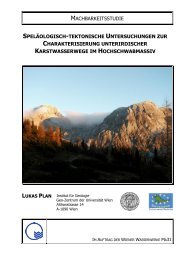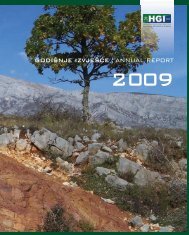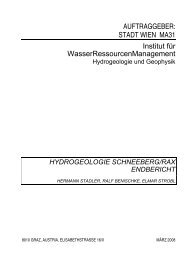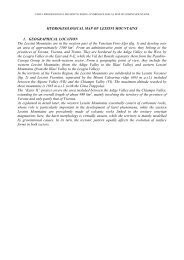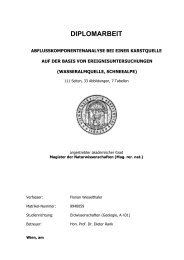Explanatory notes to the digital geological map of the Rax ... - KATER
Explanatory notes to the digital geological map of the Rax ... - KATER
Explanatory notes to the digital geological map of the Rax ... - KATER
Create successful ePaper yourself
Turn your PDF publications into a flip-book with our unique Google optimized e-Paper software.
<strong>KATER</strong> II Geology <strong>of</strong> <strong>the</strong> <strong>Rax</strong>-Schneeberg-region<br />
__________________________________________________________________________________________<br />
2 TEKTONIK<br />
2.1 Principles <strong>of</strong> NCA structural evolution<br />
The sequence <strong>of</strong> Mesozoic sediments <strong>of</strong> <strong>the</strong> NCA has lost its former crustal basement during<br />
Alpidic Orogeny. During Upper Jurassic <strong>to</strong> Tertiary times several events <strong>of</strong> folding,<br />
gravitational gliding, thrusting and final faulting have created a complex pile <strong>of</strong> nappes which<br />
rests in <strong>the</strong> north with overthrust contact on <strong>the</strong> Rhenodanubian Flysch Zone and in <strong>the</strong><br />
south with a tec<strong>to</strong>nically disturbed transgressiv contact on <strong>the</strong> Greywacke Zone.<br />
The following nappe scheme <strong>of</strong> Nor<strong>the</strong>rn Calcareous Alps can be given <strong>to</strong>day:<br />
The nor<strong>the</strong>rn (=frontal) part <strong>of</strong> <strong>the</strong> NCA (outside <strong>of</strong> <strong>the</strong> project area) is built by <strong>the</strong> Bajuvaric<br />
nappes, which one show narrow synclines and anticlines. They dip down <strong>to</strong>ward <strong>the</strong> south<br />
below <strong>the</strong> overthrusted Tyrolic nappe system. Due <strong>to</strong> <strong>the</strong>ir widespread rigide dolomitic<br />
lithology <strong>the</strong> Tyrolic nappes exhibit internal thrusting and faulting and only minor folding. The<br />
sou<strong>the</strong>rnmost nappe is <strong>the</strong> Göller Nappe with a stratigraphic succession from Triassic<br />
shallow water carbonates <strong>to</strong> Jurassic red limes<strong>to</strong>nes, marls and radiolarite.<br />
The Juvavic Nappe System represent <strong>the</strong> uppermost tec<strong>to</strong>nic element, overlying Mesozoic<br />
rocks (Tyrolic Göller Nappe) in <strong>the</strong> north and <strong>the</strong> Greywacke Zone and its transgressiv<br />
Permoscythian cover (Werfen Imbricates Zone) in <strong>the</strong> south. It can be subdivided in<strong>to</strong> a few<br />
large units (up <strong>to</strong> tens <strong>of</strong> kilometers), <strong>the</strong> Mürzalpen Nappe, Schneeberg Nappe, Hohe Wand<br />
Nappe and several smaller ones (hundreds <strong>of</strong> meters <strong>to</strong> about a kilometer), forming Klippen<br />
below or outliers above <strong>the</strong> larger ones.<br />
The contact between NCA and Greywacke Zone was a matter <strong>of</strong> long lasting controversial<br />
discussions: on <strong>the</strong> one hand <strong>the</strong>re is a transgressive contact <strong>of</strong> Permo-Skythian clastics<br />
over Lower Palaeozoic rocks <strong>of</strong> <strong>the</strong> Greywacke Zone visible; on <strong>the</strong> o<strong>the</strong>r hand <strong>the</strong> Skythian<br />
clastics (Werfen Fm.) are followed by Middle Triassic carbonates. Many authors have seen<br />
here an undisturbed sedimentary sequence. Local missing members <strong>of</strong> <strong>the</strong> sequence have<br />
been explained by only minor thrusting. O<strong>the</strong>r authors claimed that this sedimentary contact<br />
is only a virtual one. They postulated a major overthrust, separating <strong>the</strong> Permoscythian <strong>of</strong> a<br />
Tyrolic nappe system from carbonates <strong>of</strong> <strong>the</strong> Juvavic Nappe System – see PLÖCHINGER<br />
1996, TOLLMANN 1985. This question is crucial for prediction <strong>of</strong> <strong>the</strong> deep subsurface<br />
structures, especially <strong>of</strong> <strong>the</strong> position <strong>of</strong> <strong>the</strong> aquifer/aquiclude boundary. New <strong>map</strong>ping <strong>of</strong> this<br />
sou<strong>the</strong>rn margin has revealed a clear evidence for <strong>the</strong> overthrust concept. The thrust plane is<br />
marked by slices and small Klippen-like bodies <strong>of</strong> tec<strong>to</strong>nized Middle <strong>to</strong> Upper Triassic rock<br />
sequences <strong>of</strong> <strong>the</strong> Hallstatt realm and <strong>of</strong> <strong>the</strong> Meliata realm - see MANDL & ONDREJICKOVA<br />
1993, KOZUR & MOSTLER 1992.<br />
In this sense <strong>the</strong> Noric-Tyrolic Nappe System consists <strong>of</strong> <strong>the</strong> former Palaeozoic basement<br />
(Greywacke Zone) and <strong>the</strong> relictic preserved transgressiv Permotriassic (Werfen Imbricates<br />
Zone) <strong>of</strong> <strong>the</strong> Tyrolic Nappes. In <strong>the</strong> eastern NCA it has been left behind several kilometers in<br />
<strong>the</strong> south during <strong>the</strong> nappe movements.<br />
Today <strong>the</strong>re is a common agreement that <strong>the</strong> NCA depositional realm during <strong>the</strong><br />
Permotriassic was a passive continental margin between Variscian (=Hercynian)<br />
consolidated Pangäa and <strong>the</strong> Tethys ocean – see HAAS et al. 1995.<br />
Beginning in <strong>the</strong> Jurassic <strong>the</strong> Austroalpine realm (including <strong>the</strong> NCA) became separated<br />
from its European hinterland by <strong>the</strong> birth <strong>of</strong> <strong>the</strong> transtensional basin <strong>of</strong> <strong>the</strong> Penninic Ocean,<br />
which was linked by large transform faults <strong>to</strong> <strong>the</strong> opening <strong>of</strong> <strong>the</strong> Nor<strong>the</strong>rn Atlantic Ocean.<br />
18



